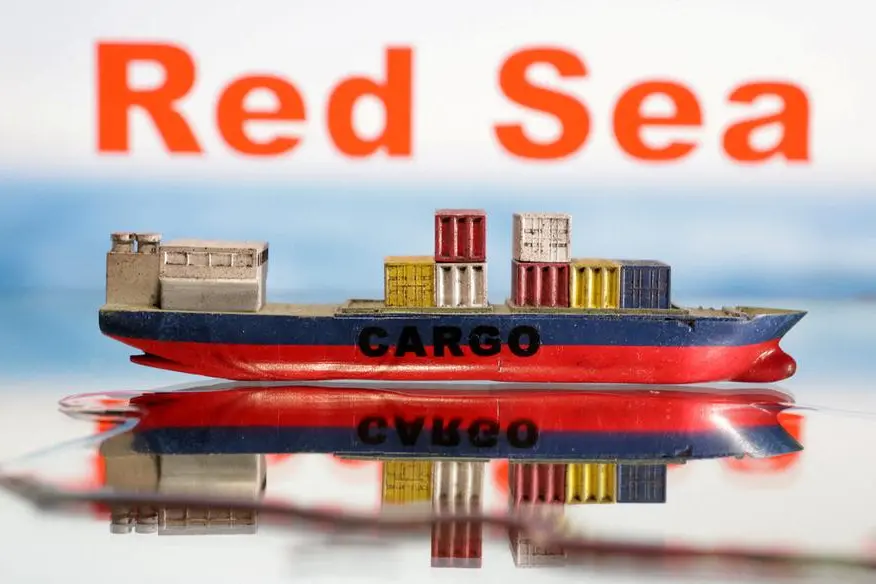PHOTO
(The opinions expressed here are those of the author, a columnist for Reuters.)
LAUNCESTON, Australia - The main impact from the escalating tensions in the Middle East and the threat to ships transiting the Red Sea isn't on crude oil prices.
It's refined fuels that are most at risk.
The missile attack on the product tanker Marlin Luanda on Jan. 26 by Yemen's Iran-aligned Houthi group underscored the risks to shipments of refined products between the major trading regions of Asia and Europe.
The tanker was carrying Russian naphtha and was under charter by global trading group Trafigura, which has subsequently said it is assessing the security risks of further Red Sea voyages.
However, the product markets in Asia and Europe have made their own assessment, sending the profit margins on producing fuels such as diesel and gasoline sharply higher.
The profit margin, or crack, on making a barrel of gasoil, the building block of diesel and jet fuel, at a typical Singapore refinery shot up 18% on Monday, ending at $25.58, up from the close of $21.68 on Jan. 26.
The crack is at the highest since Nov. 3, and the jump on Monday was the biggest one-day percentage increase in three months.
In Europe, the diesel barge refining margin rose to the highest in two months, hitting $32.84 a barrel on Monday, up from $30.85 previously.
The profit on making a barrel of 92 octane gasoline from Brent crude in Singapore increased 7.4% on Monday to $16.45, a five-month high.
MARKET TO ADJUST
While a jump in the prices of refined fuels is an expected response to the attack on the Marlin Luanda tanker, the question for the market is whether the gains are justified by actual market circumstances.
The dynamic that is most likely to play out is similar to what happened in energy markets in the wake of Russia's invasion of Ukraine in February 2022.
Prices for crude oil, refined products, thermal coal and liquefied natural gas surged after the attack amid fears of widespread disruptions to supplies from Russia as Western nations shunned and then sanctioned cargoes from Russia.
But prices retreated to below pre-invasion levels within months as the market worked out ways to manage new trade flows, with China and India taking much of the Russian crude, coal and LNG that had been flowing to Europe and some Asian buyers, such as Japan and South Korea.
The current threat to shipping in the Red Sea isn't at the same scale as the disruption caused by the invasion of Ukraine, and it's likely the market will once again be able to adjust fairly rapidly.
The main impact is likely to be higher costs, as tankers will have to re-route around the Cape of Good Hope in South Africa, a longer voyage than using the Red Sea and the Suez Canal.
But the main point is that supply from the Middle East has yet to be impacted, and it's likely that trade flows will adjust.
This is likely to see more U.S. diesel head to Europe, while refined fuels from the Middle East will likely head to Asia and the Americas at the expense of Europe.
Already this can be seen in trade flows so far in January, with commodity analysts Kpler tracking U.S. exports of diesel to Europe at 9.29 million barrels, or about 36% of the total shipments.
This is up from 31% of U.S. diesel that headed to Europe in December, but its worth noting that it's a vastly higher percentage than was typical for most of 2023, which was usually around 15% to 20%.
Asia's exports of diesel to Europe are assessed by Kpler at 12.85 million barrels in January, down from 22.93 million in December, while shipments to the Americas are up to 2.19 million barrels from 440,000 in December.
If tankers avoid the Red Sea for an extended period it's likely there will be higher prices for refined fuels in Asia and Europe. But it's also probable these will eventually reflect the increased shipping costs, and the current risk premium will ease.
The opinions expressed here are those of the author, a columnist for Reuters.
(Editing by Jamie Freed)























